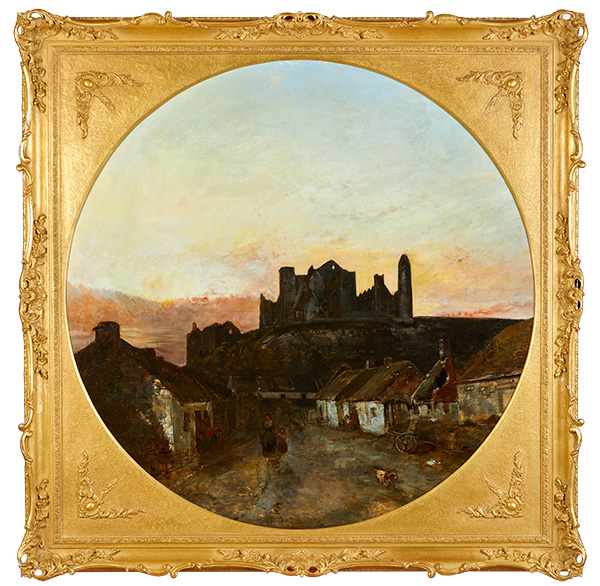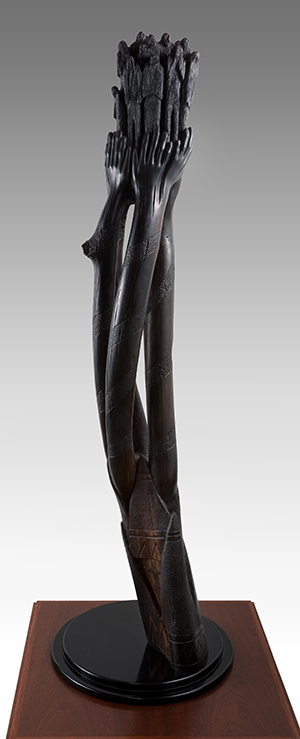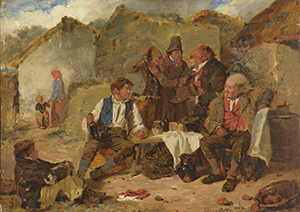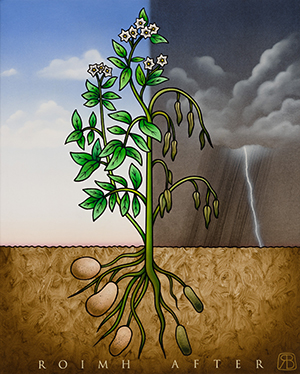‘Coming Home: Art and the Great Hunger’
Published in Issue 3 (May/June 2018), Reviews, Volume 26Coach House, Dublin Castle, www.artandthegreathunger.org
Until the end of June 2018
By Tony Canavan

Above: Henry Mark Anthony’s Sunset(1847) contrasts the majestic ruins of the Rock of Cashel towering over the more recent ruins of a society on the verge of collapse.
‘Coming Home: Art and the Great Hunger’ is the world’s largest collection of art relating to the Great Famine. Its permanent home is in Ireland’s Great Hunger Museum at Quinnipiac University, Connecticut. (Readers may remember that it featured in a previous Museum Eye by Meredith Meagher in March/April 2013.)

Above: Thank You to the Choctaw(2015), in bog oak, by Kieran Tuohy.
The Great Famine saw the death and dispersal of around two million people, followed by the emigration of a further two million to the end of the century, most of them to America. The Irish diaspora largely defines Ireland’s place in the world today and the impact of the Famine is still with its descendants both at home and abroad. That alone would make this an important exhibition but, aside from the historical significance, it is also an important collection of art for its own sake.
It is often said that Ireland lacks a body of historic art but this exhibition shows that not to be the case, even if much of the art is by British artists. The exhibition opens with some idyllic landscapes from pre-Famine Ireland, but even these ‘tourist’ views cannot always hide the poverty that existed, as poorly dressed peasants and their hovels intrude on the scene. To the modern viewer, used to the explicit depiction of war, famine and natural disaster from around the world in photographs and on screen, it may seem strange that the paintings from the years of the Famine itself do not show starving people or fields of rotting potatoes. Given the sensibilities of the times, artists were not expected to paint such images and would have found no buyers. The Illustrated London News, however, provided such views in its pages. These illustrations are not in the exhibition per se but can be seen on one of the accompanying screens,which show a range of works of art, illustration and historical material that add context to the paintings.

Above: Paintings such as Erskine Nicol’s A Knotty Point (1853) obfuscate the true horror of the period with robust, idyllic impressions of darkened cottages and shadowy landscapes.
Even decades after the catastrophe, artists found it difficult to paint graphic representations of what happened. The occasional eviction scene or ruined cottage appears, but the Famine continues to be mainly addressed by metaphor and allegory, with emigration scenes being most common. It is startling to see paintings from the late nineteenth century that depict Ireland as a land of happy peasants or sturdy farmers,but even these sanitised images of well-fed people in neat cottages dancing to a piper or fiddler cannot disguise the level of poverty. Furniture might be clean and sparkling but there is very little of it; the people are brightly dressed but closer inspection reveals clothes that have been patched and mended over years.

Above: Robert Ballagh’s Roimh After (2017).
In broader terms, it must be remembered that this is an exhibition not just of Great Famine art but also of the collection in Ireland’s Great Hunger Museumat Quinnipiac University. There are other artworks related to the Famine not included here,but, given that most emigrants ended up in the United States, it is fitting that the greatest collection of such art is preserved in this museum.
Tony Canavan is editor of Books Ireland.
















